Dry eye in dogs (i.e. keratoconjunctivitis sicca or KCS) occurs when a dog doesn’t produce enough tears to lubricate the eye. It can be painful, and sometimes even lead to blindness. To help dog parents recognize and manage their dog’s dry eye, integrative veterinarian Dr. Julie Buzby explains the causes, symptoms, diagnosis, and treatment for KCS in dogs.
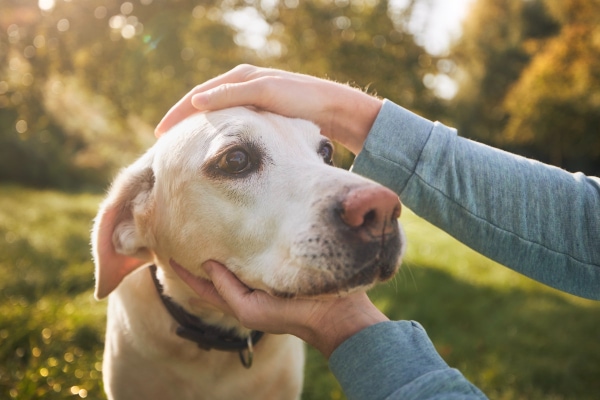
If you walk into any drugstore, you could probably find a nice selection of eyedrops for people with dry, red, or itchy eyes. And chances are good you have heard or seen some advertisements for these products too. Maybe you even use one to keep your own eyes moist and comfortable.
But what you may not know is that humans aren’t the only mammals to suffer from dry eye—up to 1.5% of dogs in North America also have dry eyes. That number may not sound that high, but it would mean that if you lined up 200 dogs, 3 of them would develop dry eye in their lifetime. That’s not an insignificant number of dogs.
What is dry eye in dogs?
As the name would imply, dry eye in dogs occurs when there is a decrease in tear production in one or both eyes. The other name for dry eye, keratoconjunctivitis sicca (KCS), includes a good description of what is going on. “Keratoconjunctivitis” refers to inflammation of the cornea (i.e. clear “window” at the front of the eye) and conjunctiva (i.e. pink tissue that covers the inner eyelids and reflects onto the eyeball). And “sicca” means dry. In other words, the surface of the eye and eye socket is dry and irritated.
It makes sense that this would happen because tears lubricate and protect the cornea and surrounding tissues. Without adequate tear production, the cornea and conjunctiva become dry, irritated, and inflamed.
What are the signs of dry eye in dogs?
In the early stages of KCS, there may be some swelling and redness of the conjunctiva and occasional eye discharge. But as the disease progresses, you may notice:
- Thickened and red conjunctiva
- White or yellowish-green, thick, ropey discharge from the eye
- Dull or dry appearance to the cornea (instead of being shiny and wet like a normal dog eye)
- Bumpy cobblestone appearance of the cornea
- Severe, frequent, or poorly-healing corneal ulcers in dogs
- Corneal pigmentation (i.e. dark or black coloration to the cornea)—especially with chronic dry eye
- Corneal vascularization (i.e. red blood vessels snaking across the cornea)
- Squinting or holding the eye closed due to pain (i.e. blepharospasm) or other signs your dog is in pain
Sometimes these changes are severe enough to lead to diminished sight or total blindness. And if a KCS-induced corneal ulcer ruptures, the dog may end up losing the eye. For these reasons, it is important not to ignore the clinical signs of dry eye.
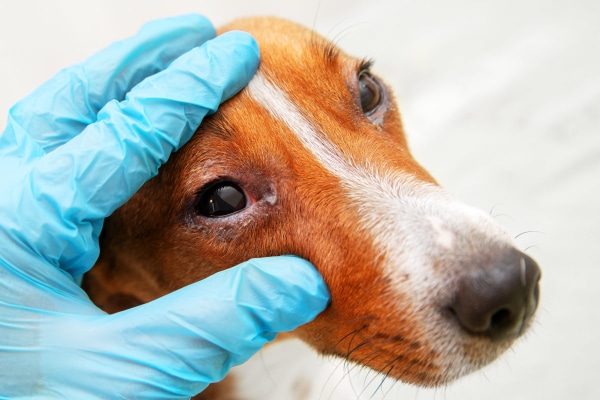
What causes dry eye in dogs?
These symptoms may show up rapidly or gradually. And they may affect one eye or both eyes. It all depends on the cause of the dry eye.
Immune-mediated destruction of tear glands
By far, the most common cause of dry eye in dogs is immune-mediated KCS. In other words, the immune system starts attacking and destroying tear-producing structures in the eye. Two glands—the gland of the third eyelid and the lacrimal gland—are responsible for producing the aqueous (i.e. water-based) portion of the dog’s tears. (There are structures that produce the oil and mucous portion of tears too. But in this article, we are primarily focusing on problems with the aqueous portion of the tear film.)
As the immune system slowly kills the tear glands, the dog will produce less and less of the liquid component of the tears, which translates to a progressively lower tear volume. As a result, the symptoms of immune-mediated KCS often start gradually and worsen over time. Typically, both eyes are affected.
There seems to be a hereditary component to immune-mediated dry eye, with the following breeds being more commonly affected:
- King Charles Cavalier Spaniel
- English Bulldog
- Lhasa Apso
- Shih Tzu
- West Highland White Terrier
- Cocker Spaniel
Some of these dog breeds are also at higher risk for cherry eye (which we are about to discuss) or allergies. Both of these conditions may predispose them to KCS as well.
Cherry eye
Cherry eye (i.e. prolapse of the gland of the third eyelid) probably got its name because it looks like there is a cherry sitting in the corner of the eye. This red bump is actually the tear gland of the third eyelid. Normally, this gland is neatly tucked under the third eyelid (i.e. tissue in the inner corner of a dog’s eye). But sometimes the gland will pop out of place and become inflamed. When this happens, it doesn’t produce as many tears.
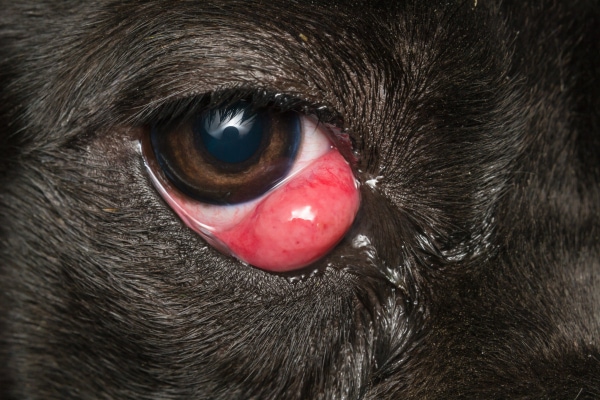
The preferred treatment option is to surgically reposition the gland of the third eyelid and tack it in place. However, about 20% of dogs who undergo this surgery will still develop KCS at some point. Alternatively, some veterinarians may elect to remove the gland of the third eyelid. This procedure predisposes 30-40% of dogs to KCS since it takes away one of the two glands that produce the aqueous portion of the tears.
Endocrine disorders
Diabetes mellitus, hypothyroidism in dogs, and Cushing’s disease in dogs may also predispose a dog to develop KCS in both eyes. In fact, I had this happen to one of my veterinary technician’s dogs.
She noticed that her middle-aged Great Dane was developing dry skin and signs of dry eye. Initially, hypothyroidism wasn’t very high on my differential list since my tech’s dog was thin, and not overweight like most hypothyroid dogs. However, my technician listened to her intuition and pushed for a thyroid panel.
Sure enough, her pup ended up being hypothyroid. Thankfully, starting a thyroid supplement significantly improved both tear production and dry skin. My tech, her dog, and I were all happy that there ended up being such a simple solution for the KCS!
Medications
Certain medications may also cause dry eye. For example, gas anesthesia and atropine can both cause KCS by affecting the nervous system’s response to the tear glands.
On the other hand, sulfa-containing medications and the non-steroidal anti-inflammatory etodolac can cause toxic damage to the tear glands. In some cases, the tear production improves once the dog stops taking the medication. But in other situations, the damage is permanent.
Damage to the tear glands
Infectious diseases, such as canine distemper virus and leptospirosis, can cause severe inflammation and damage to the tear glands. This can lead to KCS in both eyes. Plus, significant trauma to the tissue surrounding the eye can cause a decrease in tear production. Depending on the extent of damage, the dry eye may be temporary or permanent.
For example, one of my patients, an adorable Whippet puppy, got bit on the head by one of her much larger housemates. While her eye itself was not injured, the inflammation and infection from the bite damaged the tissue around the eye, including the tear glands. As a result, she developed dry eye. Thankfully, after a course of medication to reduce the inflammation and infection, the tear production rebounded in the affected eye.
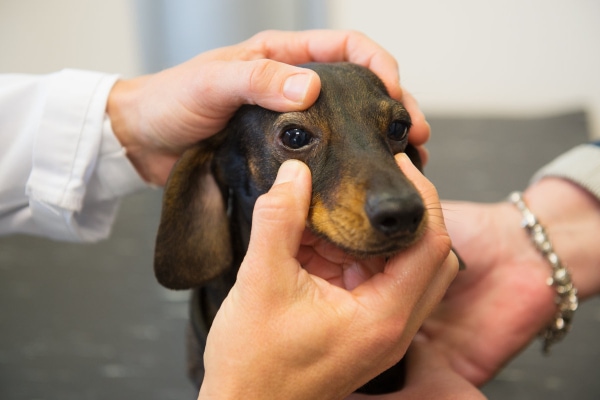
Nerve issues (i.e. neurogenic KCS)
The nervous system controls many processes in the body, including tear production. So when something damages the nerves that send signals between the cornea, tear gland, and brain, the end result can be dry eye. This is called neurogenic KCS. Often, these dogs will also have a dry nose in dogs on that side because one of the affected nerves also controls the glands that keep the nostril moist.
Sometimes the cause of neurogenic KCS is unknown (i.e. idiopathic). But other times it may be related to trauma, otitis in dogs (i.e. ear infections), inflammation, surgery on the ear, or anatomical malformations.
Congenital malformation
In some dogs, the tear glands either don’t form properly or don’t function correctly from birth. Thus, these dogs start showing signs of KCS at a young age.
While it is fairly rare, I did see a case of congenital KCS in a tiny Yorkie puppy. At the first puppy visit, his mom mentioned that his eyes were always a bit crusty. And sure enough, when I tested his tear production, it was almost non-existent in one eye and very low in the other.
How does the vet diagnose dry eye?
Just like I did with that Yorkie puppy, measuring tear production with a Schirmer tear test (STT) is the main way vets reach a diagnosis of KCS. Using the STT to assess tear production is often part of the ophthalmic exam. But it is especially important for dogs who are symptomatic or have risk factors for KCS.
Schirmer Tear Test (STT)
To perform the STT, the vet will tuck a special strip of paper under the dog’s lower eyelid so it rests between the cornea and the inner eyelid. The paper absorbs the dog’s tears and wicks them upward. Then, after one minute, the vet will remove the STT paper and look at how much of it is wet with tears. The paper is marked in millimeter increments. This allows the vet to determine that the dog produced “X” millimeters per minute (mm/min) of tears.
Based on the results, the vet will classify the dog’s tear production using these guidelines:
| Tear production | Interpretation |
|---|---|
| Greater than 15 mm/min | Normal |
| 11-14 mm/min | Mild KCS |
| 6-10 mm/min | Moderate KCS |
| Less than 5 mm/min | Severe KCS |
(Please note that these are guidelines, not set-in-stone rules. The vet will also take into account how the dog’s eyes look when making the diagnosis. For example, an STT of 13 or 14 in a dog with normal-looking eyes may not be indicative of KCS, especially if the abnormal reading isn’t repeatable on a different day.)
Corneal staining
Since dogs with dry eyes are prone to corneal ulceration, the vet may also want to apply fluorescein to the eyes. This is a special stain that will adhere to any damaged areas of the cornea. And it will slide right off a normal, healthy cornea. After applying the fluorescein, the vet will rinse the eye and then illuminate the eye with a black light.
Any remaining stain will light up bright green. In mild or early KCS, the corneal surface may be covered with tiny speckles of green. This abnormal appearance shows the surface of the cornea is rough instead of smooth, and points to KCS as a potential cause. And if a corneal ulcer is present, the stain will highlight its size, shape, and location.
Finding corneal ulcers (and watching for signs of ulcers like increased redness, pain, or squinting) is very important. Ulcers can quickly go south in dogs with KCS. It isn’t all that unusual for the ulcer to rapidly become deep, the cornea to start melting, or the eye to rupture, if not treated promptly and appropriately. This can easily cause a dog to become blind or lose an eye.
Additional tests
Sometimes the veterinarian or veterinary ophthalmologist may want to perform a few more tests to better understand what is going on with your dog’s eye. For example, if the vet suspects that the dog has an issue with the oil or mucous portion of the tears, rather than the aqueous (i.e. water) portion, he or she may recommend a tear film break-up time test. (Dogs with this type of dry eye may have a normal STT because STT primarily measures the water-based component of tears.)
What is the treatment for dry eye in dogs?
Once your veterinarian reaches a diagnosis of KCS, he or she will discuss the treatment plan with you. Since there are a variety of causes and degrees of dry eye, the plan may vary from dog to dog and from one point in time to another.

Cyclosporine and tacrolimus
Dogs with immune-mediated KCS (which causes the vast majority of cases of dry eye in dogs) may respond well to immunomodulatory medications like cyclosporine or tacrolimus. In fact, dogs with an STT between 2 and 14 mm/min will have an 80% chance of regaining normal tear production on cyclosporine. That is pretty good! However, for dogs with an initial STT of 0 to 1 mm/min, that number drops to less than 50%.
Cyclosporine and tacrolimus help boost tear production by altering the effects of the immune system on the tear gland. These medications seem to be able to both reduce inflammation in the tear gland (and thus destruction) and also stimulate tear production.
Currently, applying cyclosporine or tacrolimus to the eye as a drop or ointment seems to be the most effective. However, researchers continue to look into other ways to deliver the medications. One such option is the use of episcleral cyclosporine implants in dogs with KCS.
It may take up to a couple of months for tear production to improve. And your dog will probably need life-long treatment. However, with time, the goal is to get to the lowest dose of cyclosporine and/or tacrolimus that controls your dog’s dry eye. Your vet can help you find the medication (or medications), dose, and schedule that is right for your dog.
Pilocarpine
Dogs with neurogenic KCS may respond well to a tear stimulant like oral or topical pilocarpine. This medication acts like the signaling molecules that the nerves would normally use to control tearing and moisture production in the nostrils. Thus, if nerve signaling is the problem, pilocarpine can help increase tear production. As an added bonus, it can also improve the dry, crusty nose that plagues many dogs with neurogenic KCS.
Like the immunomodulatory drugs, pilocarpine may also take several weeks (or months) to reach full effect. And dogs often need to remain on it for the duration of their life.
Artificial tears
Dogs with dry eye also benefit from supportive therapy with artificial tears. These medications don’t increase tear production like pilocarpine, cyclosporine, and tacrolimus, so they often aren’t a stand-alone home remedy for dry eye. But tear replacement products do help protect and lubricate the eye, which makes them a valuable part of the treatment plan.
There are a variety of veterinary formulations and human over-the-counter artificial tears on the market. They may come as a gel, ointment, or liquid and contain different lubricating agents. Your veterinarian will help you find the product that works best for your dog’s situation and discuss the ideal application frequency (usually every 4-6 hours but the frequency varies from case to case.)
Depending on how the dog responds to the other treatments, artificial tears may be a temporary solution until tear production improves. Or, they may be a permanent necessity if the dog doesn’t respond (or only somewhat responds) to pilocarpine, cyclosporine, or tacrolimus.
The Yorkie puppy with congenital KCS that I mentioned earlier happened to be one such case. While treatment never got his tear production over 5 mm/min, he had minimal issues with his eyes. This was in huge part due to the dedication of his parents, who applied artificial tears every waking hour of his life. The artificial tears weren’t as good as real tears, but they provided him with comfortable, normal vision for thirteen years.
Cleaning the eye
Using a warm washcloth to wipe the debris from the eye several times a day can also help your dog be more comfortable. Plus, it is a good idea to clean the eye before applying medications. Otherwise, the eye discharge can make the medications less effective.
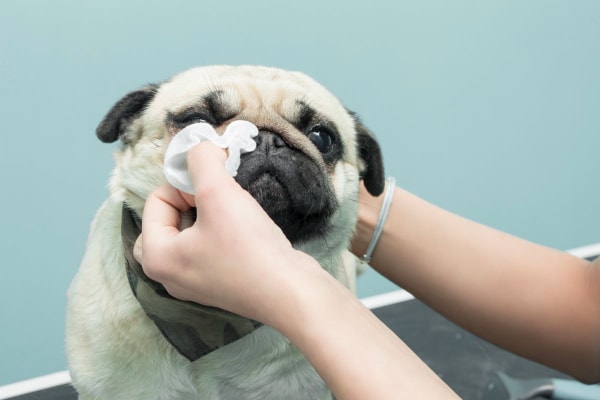
A note about applying eye medications:
As a general rule, you should wait at least five minutes between applying eye medications. This allows the first medication to get absorbed before you put the next one in. Also, ointments should be the last thing you apply because they can decrease the penetration of other medications. (However, ultimately, you should follow your veterinarian’s instructions because he or she knows your dog’s particular case.)
Treatment of secondary issues
Since tears help wash away debris and bacteria, dogs with dry eye may be more prone to eye infections and inflammation. This means they may periodically need antibiotic eye drops or ointment to combat infection. Or they may benefit from topical steroids to reduce inflammation.
As mentioned earlier, dogs with dry eye are also susceptible to corneal ulcers. Recognizing and treating ulcers promptly is important for giving your dog the best chance at maintaining a comfortable and visual eye.
Parotid duct transposition surgery
In severe cases of dry eye that do not respond to treatment, a veterinary ophthalmologist may perform parotid duct transposition surgery. The procedure involves re-routing the parotid salivary gland duct from the mouth into the corner of the eye. Since saliva has a similar composition to tears, it makes an adequate tear substitute. However, the complication rate for this procedure is high, making it a less-than-ideal solution.
Enucleation
If rerouting the salivary gland is not a good choice, and your dog is not responding to medical therapy, enucleation (i.e. removal of the eye) is another option. I understand that removing your dog’s eye may sound extreme. But it can significantly improve a dog’s quality of life by eliminating the pain and infection which may result from long-term severe dry eye.
What is the outlook for dogs with dry eye?
As you may have gathered from reading about the treatment of dry eye, the prognosis is variable. It depends on the underlying cause, the dog’s response to treatment, and the lifestyle of the dog and family.
Sometimes the KCS is only temporary, like in my tech’s hypothyroid dog. But often, KCS is life-long and will require long-term medications. This can get expensive and take a lot of time.
While hourly application of eye drops was possible for the Yorkie’s family, this would not be sustainable for many families. And that is ok (and definitely not my expectation that you would do that)! You need to find what works best for YOUR family and YOUR dog.
Work with your veterinarian to manage your dog’s dry eye
Your veterinarian can help you create (and modify) a dry eye management plan for your dog. There are probably going to be some bumps in the road along the way. And you may need to figure out how to give your dog eye medication multiple times a day while still enjoying time with your dog and living your life. But the good news is that with diligent management and help from your veterinarian, your dog can, hopefully, continue to have comfortable, visual eyes for years.
Does your dog have dry eye?
Please share your favorite tips or tricks so other dog parents can benefit from your experience.


my dog Petra.. the vet pierced her ear drum adminstering drops for ear infection..4 months ago. she is on all sorts of drops. the Pilocarpine helps with wetting eye. nose gets dry. but her ear cant be treated. but its driving her mad, so itchy. dont know what to do. just been putting vaseline on outer skin of ear, as making sore, keep scratching
Dear Kay,
I am sorry Petra is living with all of these ongoing issues. I understand your concern and wish there was some way I could help. It may be time to consider a consultation with a specialist. Hoping you can find a way to offer your sweet girl relief. Praying for answers and a clear path forward.
I have a 10 year old Yorkie that has dry eye in one eye. I have been using a steroid for years and it helps but i have to use artificial tears a couple of times throughout the day to ensure his eye is wet enough to keep it from crusting up. I’m having the hardest time finding plain artificial tears to treat in between the steroid. I have been to every store/pharmacy in my local town and none of them have any in stock or don’t carry plain artificial tears. There are several “dog” eye drops on Amazon but I’m not sure which is best or shouldn’t be used. His dry eye was determined not to be neurogenic when he was first diagnosed because his “nose wasn’t dry”. But I suspect that it is neurogenic because now his nose is very dry only on the one side. Please help me determine what eye drops are safe to use during the day in between his steroid ointment treatments. I don’t mind buying from Amazon, at this point I think it would be best to ensure I can get the same thing again.
Hi Missy,
I am so sorry you are having such a hard time finding what you need to take care of your pup. Have you asked your vet if they have a way to order the artificial tears for you? You may be able to find them on pet pharmacy sites such as Chewy. You could also ask the pharmacist at the local drug store as they may have the ability to special order them with a prescription from your vet. I am not familiar with all the over-the-counter products available on Amazon, or I would be glad to give you a recommendation. Hoping you can find a reputable source and get the drops you need quickly. Best wishes and good luck!
Hello, thank you for your article, I always find them very informative.
My dog had an ulcer pop up on his eye, the vet thought it was due to trauma & It took a month to heal. Then it popped up again 6 months later, this time another followed in his other eye, one was quite large. It took roughly 3 months for these to heal. He was on 0.5% chloramphenicol eye drops, remend dry eye and remend corneal repair gel. No other tests were done until his dry eye was confirmed with the schrimmer (7&10mm).
A few weeks after they healed , he suddenly passed away. Could these ulcers have been a sign of something else? I’ve since learned about chloramphenical and its possible side effects, and that this was a very long time for ulcers to take to heal. He didn’t have any blood tests even when on this topical medication.
For anyone in a similar situation with sudden ulcers , I would advise for you to ask the vet look into the cause of the dry eye rather than just trust it’s down to just the dry eye, just to cover all possibilities. Could that have saved my dog? I’m not sure , but I imagine something was going on or could it have just been a coincidence?
Dear Anonymous,
I am so sorry for the sudden loss of your dog. I have been going through every possible scenario in my mind and just can’t make these symptoms fit together to cause his passing. I don’t think we will ever know the true cause of his death, and I wish there was more I could say to bring you closure. Try to let go of the burden of guilt you are carrying. You didn’t do anything wrong. I pray as time passes you will allow yourself grace and be comforted knowing your boy was well loved. Wishing you healing and peace. ♥
I have a nearly 16 yr old female Bichon Frise who has a cherry eye. We attempted a few different regimens of drops prescribed by our vet, neither having any impact. The cherry continues to grow. Fortunately (at this very moment) it doesn’t seem to phase her, but it keeps growing. She also has very few teeth left from having them removed over the years following teeth cleanings. She is rather fragile, nearly deaf and blind, “leaks” in her sleep, sleeping more and more and more, obsessively following my husband (he IS her “person”), and losing her spunk more and more with each passing day. We are content and at peace to just keep her happy (quality over quantity of life), but is there anything we can do (other than surgery) to help with her cherry eye? Or is it….”time”. While we obviously don’t want to jump the gun, we also don’t want her to be utterly miserable.
Hi Alice,
I understand how difficult it can be to watch our pets grow old. It sounds like you are doing an amazing job caring for your sweet girl and I agree completely with what you said about quality of live over quantity. In terms of her cherry eye, the non-surgical options do usually involve lubricating or anti-inflammatory/antibiotic drops, which I suspect are what your veterinarian has already had you try.
Since you also asked about if it was time to let her go, I wanted to provide a few resources that can sometimes help dog parents with that decision:
1. Using a Quality of Life Scale for Dogs – This is a great way to establish a baseline for your dog’s quality of life and then track how it changes over time
2. How Will You Know When It’s Time to Euthanize Your Dog? 5 Caring, Heartfelt Messages
3. Preparing for Your Dog’s Euthanasia: 10 Thoughts for Peace
It is such a heart wrenching decision, and my heart goes out to you. I hope you are able to find some clear answers about how best to help her and when it is time to set her free.